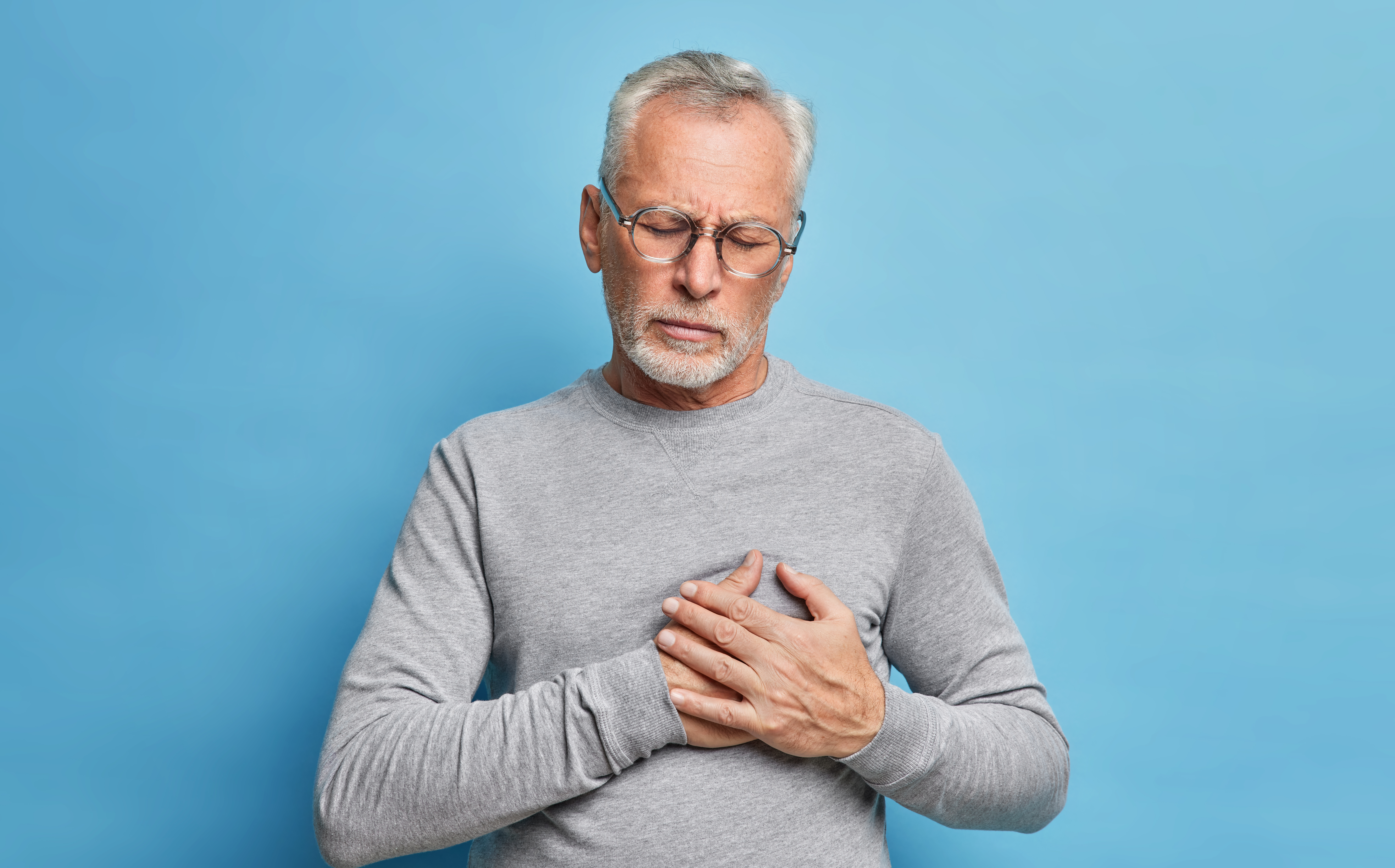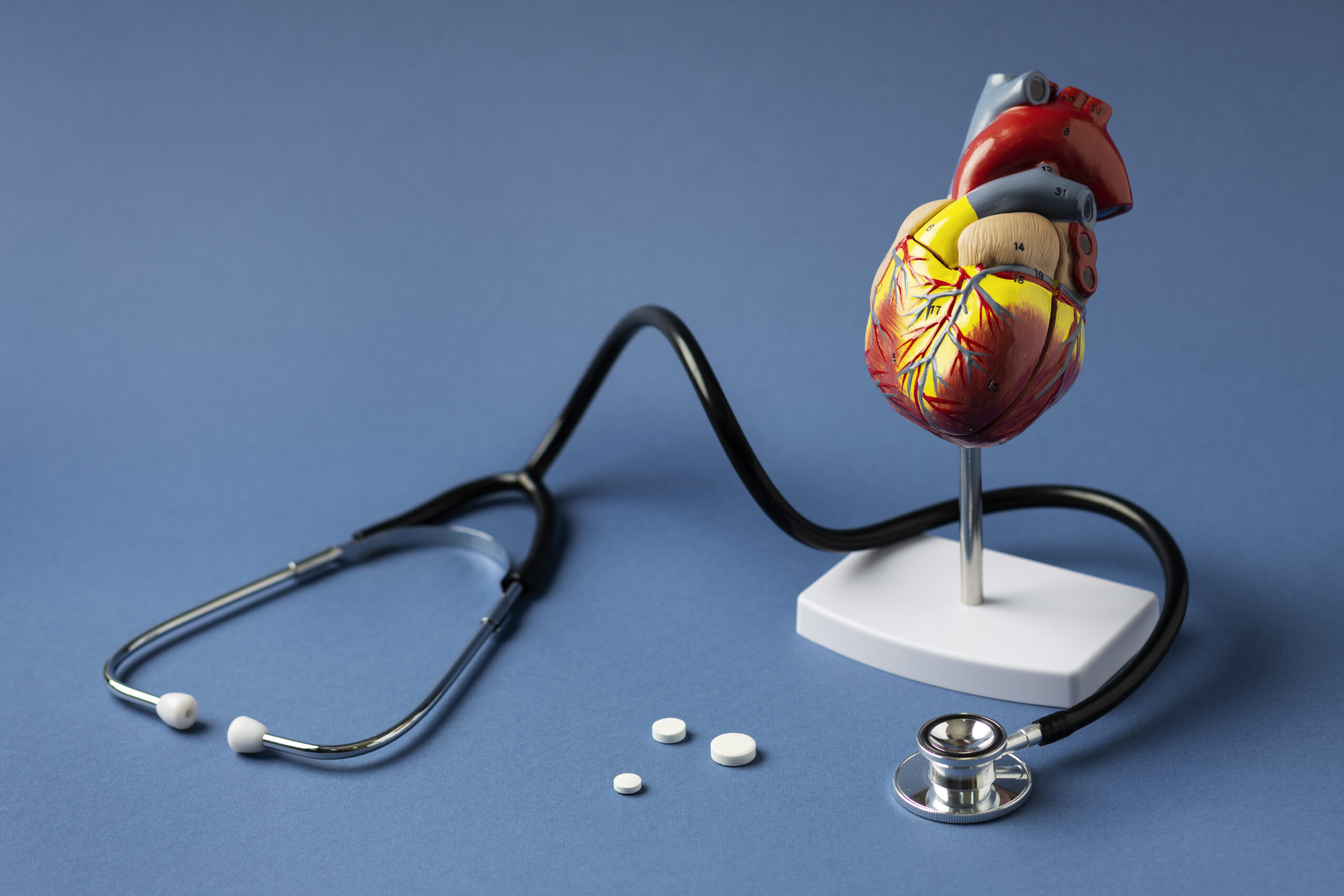Chest pain may arise from various underlying pathologies, including cardiovascular, neurological, gastrointestinal, or musculoskeletal disorders. This symptom can manifest on both the right and left sides of the chest during physical exertion and at rest. Patients often report worsening of pain during activities such as coughing, swallowing, and breathing. Chest pain may present as anginal or pleural.
The gravity of chest pain should not be underestimated, considering that cardiovascular diseases are still a common cause of premature death worldwide. Seeking medical attention is strongly advised, as the symptoms of chest pain may signify an unhealthy lifestyle, lack of physical activity, or a severe underlying condition. Chest pain is not exclusive to the elderly; young individuals may also experience it.

Chest pain![]() can take many forms. Some people feel tightness in the chest, some stinging behind the breastbone, and others report a tearing, burning sensation, stabbing, or radiating pain. This pain may have a different character: increasing gradually or appearing suddenly with great intensity, long-term or short-term.
can take many forms. Some people feel tightness in the chest, some stinging behind the breastbone, and others report a tearing, burning sensation, stabbing, or radiating pain. This pain may have a different character: increasing gradually or appearing suddenly with great intensity, long-term or short-term.
Chest pain is usually a symptom of health problems. Below, find the most common ones.
Chest pain is a common symptom caused by several cardiovascular diseases, including heart and large vessel diseases. Among these, heart attack, angina pectoris, pericarditis, aortic dissection, myocarditis, and hypertrophic cardiomyopathy are some of the most common conditions that can cause chest tightness. If these symptoms occur, it is crucial to seek medical help immediately.
Heart attack![]() is characterized by sudden, long-lasting pain in the sternum that radiates to the jaw and left shoulder. It is exceptionally intense and crushing, making it difficult to catch your breath. Sometimes, it radiates to the hands and neck, accompanied by dizziness, cough, and nausea.
is characterized by sudden, long-lasting pain in the sternum that radiates to the jaw and left shoulder. It is exceptionally intense and crushing, making it difficult to catch your breath. Sometimes, it radiates to the hands and neck, accompanied by dizziness, cough, and nausea.
Chest pain may also occur in the pre-infarct state. Then, the patient may become short of breath even during slight exertion. This pain may appear at rest and is often accompanied by nausea, vomiting, weakness, pale skin, excessive sweating, and increased heart and pulse rate. Chest pain does not stop after taking medication or stopping exercise.
A heart attack usually occurs after exercise or under severe stress. The symptoms![]() usually last over 20 minutes and do not improve with rest or after taking nitroglycerin. The most common symptoms are below.
usually last over 20 minutes and do not improve with rest or after taking nitroglycerin. The most common symptoms are below.
Pain behind the sternum, typically, is a feeling of pain, weight, pressure, squeezing or burning, and sometimes discomfort that is difficult to describe. It may radiate to the neck, jaw, one or both shoulders/arms, upper abdomen, and rarely to the interscapular region. Some people experience pain mainly in these areas, with no pain in the chest.
The symptoms do not change when changing body position but may increase with exercise and decrease at rest. The pain may be accompanied by fear of death, as well as other symptoms such as sweating, nausea, vomiting, shortness of breath, and fainting.
Sudden shortness of breath on exertion means that when a person tries to exercise (e.g., walk), they feel short of air, and this symptom has not occurred before or has suddenly become much more severe. This symptom may accompany pain or replace it – especially in people with diabetes or seniors, whose pain perception is often impaired.
Such symptoms, severe abdominal pain with vomiting and nausea, are not typical of a heart attack but are among the possible symptoms that may occur, especially in seniors, women, and patients with diabetes, kidney failure, or dementia. It is characteristic that such symptoms appear suddenly without a clear cause. Some patients may feel that it is severe indigestion. These may or may not be accompanied by the other symptoms![]() mentioned.
mentioned.
There may also be:
To sum up, a heart attack manifests itself differently in each patient, and it is impossible to assess for yourself whether the symptoms we experience are actually due to a heart attack. People who have already been diagnosed with coronary artery disease should be particularly vigilant about the occurrence of a heart attack. If you have any doubts, contact your doctor or emergency services immediately.
If you suspect a heart attack in yourself or someone close to you, call the emergency telephone immediately, even if you are not sure of the diagnosis.
Angina pectoris![]() is another condition that can cause chest pain. Patients may complain of retrosternal pain, which they describe as burning, crushing, or squeezing. This pain may radiate to the left shoulder, hand, or jaw and usually occurs after physical exercise or a stressful situation. Chest pain stops after a few minutes of rest or after taking medication.
is another condition that can cause chest pain. Patients may complain of retrosternal pain, which they describe as burning, crushing, or squeezing. This pain may radiate to the left shoulder, hand, or jaw and usually occurs after physical exercise or a stressful situation. Chest pain stops after a few minutes of rest or after taking medication.
Pericarditis![]() (heart inflammation) is characterized by stabbing chest pain often accompanied by a dry cough and shortness of breath. It may be preceded by muscle and joint pain and general malaise. Chest pain worsens when breathing, swallowing, or lying down but improves when the body bends forward.
(heart inflammation) is characterized by stabbing chest pain often accompanied by a dry cough and shortness of breath. It may be preceded by muscle and joint pain and general malaise. Chest pain worsens when breathing, swallowing, or lying down but improves when the body bends forward.
Aortic dissection![]() is a sudden and extremely severe condition that can cause excruciating pain in the chest and back. This pain may be accompanied by symptoms such as stroke, syncope, or lower limb ischemia.
is a sudden and extremely severe condition that can cause excruciating pain in the chest and back. This pain may be accompanied by symptoms such as stroke, syncope, or lower limb ischemia.
Myocarditis![]() is another condition that can cause chest pain, along with fever, shortness of breath, fatigue, and palpitations.
is another condition that can cause chest pain, along with fever, shortness of breath, fatigue, and palpitations.
Hypertrophic cardiomyopathy![]() is characterized by burning, pressing, or bursting pain in the chest that may radiate to the mandible and left upper limb. The pain occurs during exercise and disappears after about five minutes.
is characterized by burning, pressing, or bursting pain in the chest that may radiate to the mandible and left upper limb. The pain occurs during exercise and disappears after about five minutes.

Various diseases of the digestive system![]() may cause chest pain, which can sometimes go unnoticed. Heartburn is a common and non-fatal ailment. The condition causes a burning sensation behind the breastbone, particularly after consuming a large meal. It may also cause pain or discomfort in the upper abdomen, referred to as the epigastric region.
may cause chest pain, which can sometimes go unnoticed. Heartburn is a common and non-fatal ailment. The condition causes a burning sensation behind the breastbone, particularly after consuming a large meal. It may also cause pain or discomfort in the upper abdomen, referred to as the epigastric region.
Other digestive system diseases can also manifest as chest pain. Gastroesophageal reflux![]() , for instance, is characterized by the backflow of acidic food from the stomach into the esophagus. This condition causes discomfort or chest pain, which intensifies when bending or lying on the back.
, for instance, is characterized by the backflow of acidic food from the stomach into the esophagus. This condition causes discomfort or chest pain, which intensifies when bending or lying on the back.
Esophageal rupture![]() is a severe, sudden, and burning retrosternal pain that follows violent vomiting. Pancreatitis
is a severe, sudden, and burning retrosternal pain that follows violent vomiting. Pancreatitis![]() , on the other hand, causes pain in the lower part of the chest or upper abdomen, primarily on the left side, which often radiates to the back. The condition may also be accompanied by nausea, vomiting, and fever and may, in severe cases, lead to shock.
, on the other hand, causes pain in the lower part of the chest or upper abdomen, primarily on the left side, which often radiates to the back. The condition may also be accompanied by nausea, vomiting, and fever and may, in severe cases, lead to shock.
Biliary tract diseases can also cause recurrent pain in the upper right abdomen or upper abdomen, which appears after eating. Lastly, esophageal motility disorders can cause long-lasting chest pain, which can be accompanied by difficulty swallowing.
Pain in the chest may also be caused by diseases of the lungs![]() , less often of the bronchi or trachea. Those include:
, less often of the bronchi or trachea. Those include:
The chest wall comprises multiple bones, ligaments, joints, and muscles interconnected by nerves. These components may engender pain. Chest discomfort may arise from inflammation in the sternocostal or sternoclavicular joints, degenerative changes in the spine, or chest injuries. Injuries typically induce one-sided pain, with localizing characteristics, exacerbated by deep breaths or coughing and pressure applied to the injury site.
Infectious diseases may also cause chest pain. Neuralgia resulting from nerve inflammation, as seen in shingles, is one such ailment. Shingles are caused by the activation of the varicella-zoster virus, resulting in severe pain that manifests as a one-sided rash limited to a part of the chest skin under which the affected nerve runs. Symptoms may also arise when other structures compress the nerve.
Physical exercise, particularly in untrained individuals, may result in chest pain. This type of pain is due to muscle strain and typically resolves after several days of rest unless an injury has occurred.
Psychogenic chest pain may also exist. Anxiety syndromes and neurotic disorders may produce symptoms resembling the aforementioned types of pain. Hypochondria may account for some cases of chest pain. This condition is challenging to diagnose and only possible once other organic causes of pain have been excluded.
Since it is not so easy to determine where chest pain comes from, it is even more difficult in such a short article to answer the question when it is disturbing and when it is not. Therefore, if you have any questions, you should contact your doctor and resolve them as soon as possible.
Nevertheless, certain features of chest pain indicate the absolute need to contact a doctor immediately:
Chest pain may have several serious and life-threatening causes. However, much more often (especially in people without serious diseases), the cause of the symptoms is harmless. As already mentioned, there are many structures in and around the chest that can hurt, such as:
As mentioned previously, chest pain may be a symptom of a severe ailment. Therefore, the primary objective of the physician at the initial stage will be to exclude these ailments.
Some of the first tests a specialist can use to diagnose the cause of chest pain include:
Depending on the results from the first tests for chest pain, the patient may need more testing, like:

The treatment relies on the cause of this ailment. If a heart attack is causing chest pain, the patient needs to get emergency treatment as soon as possible. It may include medication and surgery to repair blood flow to the organ.
If a noncardiac disease generates the problem, the specialist will propose treatment options. Depending on your illness and how bad it is, they may suggest: